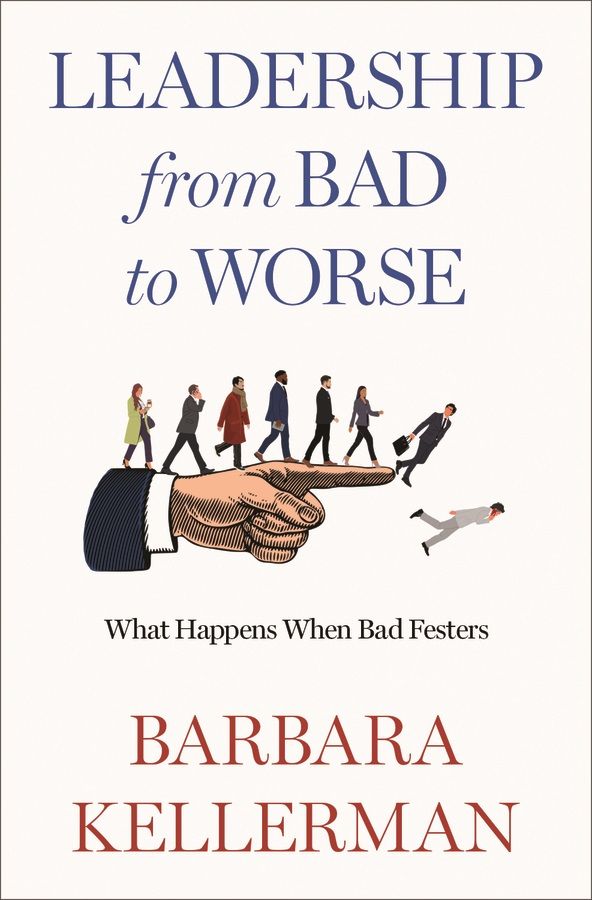We’ve all worked for bosses who could have been better — in some cases much better — but inexplicably they remain in charge. Barbara Kellerman has been studying that phenomenon for much of her career. A Fellow at the Harvard Kennedy School’s Center for Public Leadership, Kellerman has written several books on bad leadership, exploring why it matters, how it’s changed in the digital age and what we can do when we don’t trust the people in charge of our companies or communities. Her latest book, “Leadership from Bad to Worse: What Happens When Bad Festers,” is both a cautionary tale and a call to action. In the excerpt below, she details the early indicators of poor leadership — and why we are obligated to act when we see them.
—Audrey Goodson Kingo

Photo Credit: Oxford University Press
Excerpt from, “Leadership from Bad to Worse: What Happens When Bad Festers.”
When they take power, many leaders, probably most, assure their followers that things will get better. That their lives will somehow improve. After all, that’s how leaders get to be leaders in the first place. By persuading their followers that they have some sort of secret sauce that will enable them to provide what other leaders could not or would not.
What, then, distinguishes leaders who start out bad from leaders who start out good? Questions like these are impossible to answer with precision. We are talking humans, not widgets, and humans don’t lend themselves to criteria or measurements that are exact. But in general we can say that leaders who are good, as in both ethical and effective, tend from the get-go to be more reasonable and realistic than leaders who are bad, as in unethical, ineffective, or both. Good leaders avoid the spectacularly grandiose. They avoid the implication that they and they alone can save us from ourselves.
Bad leaders, in contrast, present themselves as heroes or even saviors, capable of greatness, of transcendence.
Bad leaders promise their followers the moon and the stars, a future that is a dreamscape in which the “other” will go down in flames, while their own every need will be met and their own every wish will come true. They envision a transformation—a change in people’s circumstances so great that their future will be completely different from their past and even from their present.
Whereas good leaders remain anchored in the possible, bad leaders get carried away to the land of the impossible. This capacity to threaten hell and damnation, to promise heaven on earth, and to make it all seem real as opposed to unreal is, of course, what appeals to followers. Think of it as the ultimate sales pitch in which leaders offer their wares and followers end up buying what the leader is selling.
It’s easy to see why sometimes the sales pitch works. First, bad leaders claim that they, and they alone, can lead their followers to the promised land. They insist that only they have the will and skill to lead, which implies that unless the leader is in charge and free to do what they want, the promised land will remain out of reach forever. Second, this pitch appeals especially to followers who are angry or alienated, who feel they have been dismissed or demeaned. It also appeals to followers who want tomorrow what they lack today. Finally, the pitch finds fertile soil in contexts that feel deficient — damaged or deprived, unstable or insecure, frustrating or alienating, threatening or downright dangerous. Contexts that could and should be improved, contexts in which betterment is not just wanted but needed.
Spotting the Signs of Bad Leadership
Most leaders tend at the start of their tenures to be optimistic, to depict a future that is light and sunny as opposed to dark and cloudy. So how can we tell if a particular leader is at the start of a progression that will go from bad to worse, a progression to be dreaded and possibly feared?
There is no science to which we can turn, no expert to help us make the distinction. Still, there are some telltale signs, some indicators that signal the leader’s intentions and directions.
1. Past is prologue. What the leader did in the past suggests what the leader will do in the future.
2. Words matter. Listen to what the leader says and take seriously what is said.
3. Get real. Is the leader anchored in reality? Or does the leader’s utopian vision smack of grandiosity—personal grandiosity, professional grandiosity, and, or political grandiosity—and even fantasy?
4. Teams are important. Who is on the leader’s team? Specifically, who are the leader’s closest aides and associates, and what do they suggest?
5. Strong preferences suggest probable priorities. What the leader most cares about likely will determine what the leader does.
We are not, in sum, devoid of information, even at the start. We do have some signposts—some indicators of whether leaders are bad and likely to get worse.
Taking Action Early
Once leaders are bad, once they are anywhere along the continuum from bad to worse, it is highly unlikely they will intercept their own progression. To expect otherwise, to expect bad leaders to self-correct, is almost always fruitless and foolish.
Where does this leave us? The answer is as obvious as it is unsatisfying. If leaders will not stop themselves from being bad, others must do the heavy lifting. Either another leader, which happens only rarely and usually belatedly. Or, somewhat more frequently, the leader’s followers.
Who, broadly defined, are these followers? They include at least these three groups: (1) members of the leader’s team, that is, their immediate entourage or inner circle; (2) members of the leader’s tribe, that is, their most eager and enthusiastic supporters, either active or passive; and (3) members of the public broadly defined, that is, people who are outside the leader’s sphere of influence but nevertheless follow their lead because it is the path of least resistance. They might simply be bystanders, ordinary people who are paying attention but refraining from getting involved. Still, such bystander followers matter. By doing nothing and saying nothing, they have an impact. They are supporting implicitly even if not explicitly whoever has power and authority.
The answer to the question of what to do when bad leadership happens is unsatisfying precisely because even followers who detest their bad leaders are unlikely to storm the castle. History testifies repeatedly to how followers of bad leaders are, typically, more incentivized to do nothing than to do something. To do nothing to get rid of the bad leader rather than to take the risk of fighting what they likely consider to be a lost cause. Or even to invest the time and energy involved in taking on a bad leader when the costs are likely to outweigh the benefits. It is why bad leadership proliferates. It is why even though we constantly rail against bad leadership, most of the time nothing and no one stops or even slows it. The truth is that mostly we are unlikely even to lift a finger to diminish what we despise.
Because the progression from bad leadership to worse leadership is an incremental process — one that tends to move from one phase to the next slowly — it is easier to stop that progression sooner rather than later, when it has become toxic. If we understood that progression, we might be more likely to intervene early on, when intervening is easier and has a greater chance of being successful. Again, it’s up to us. If we don’t block bad leaders, they won’t be blocked — or stopped.
The first phase of bad leadership is the rough equivalent of a blinking yellow light. It means that followers should proceed with caution. Whenever leaders paint a picture of a future almost unimaginably better than the past and the present, attention should be paid. And whenever leaders warn that without them the world will come to an end, attention should be paid. Finally, whenever leaders send the message that they and they alone ought to lead, that no one else can possibly take their place, attention should be paid.
I am not a Pollyanna. I get that none of this is easy, but just because we are saddled with a bad leader does not mean we have to go along. We can choose not to follow. To be sure, choosing not to follow is not always easy. Sometimes it is difficult, even to the point of being dangerous personally, politically, or professionally, or maybe even all three. Still, being aware of our options, understanding that we have choices — especially early in the process, before bad leadership congeals — is important.
Excerpted with permission from Leadership from Bad to Worse by Barbara Kellerman. Copyright @2024 by Oxford University Press



